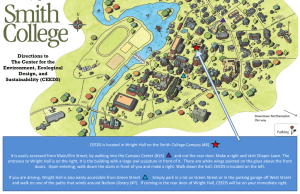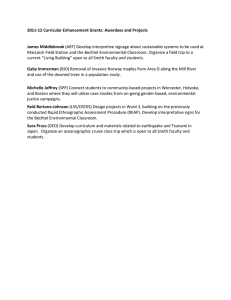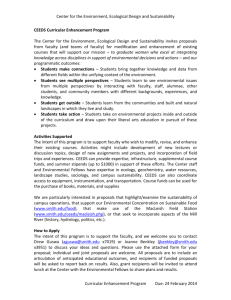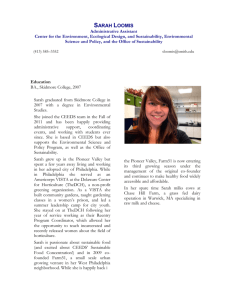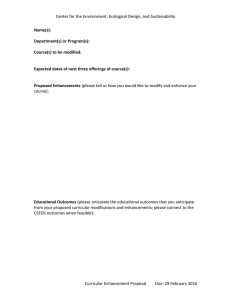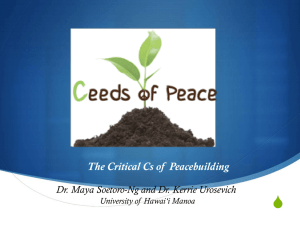Center for the Environment, Ecological Design, and Sustainability Smith College
advertisement
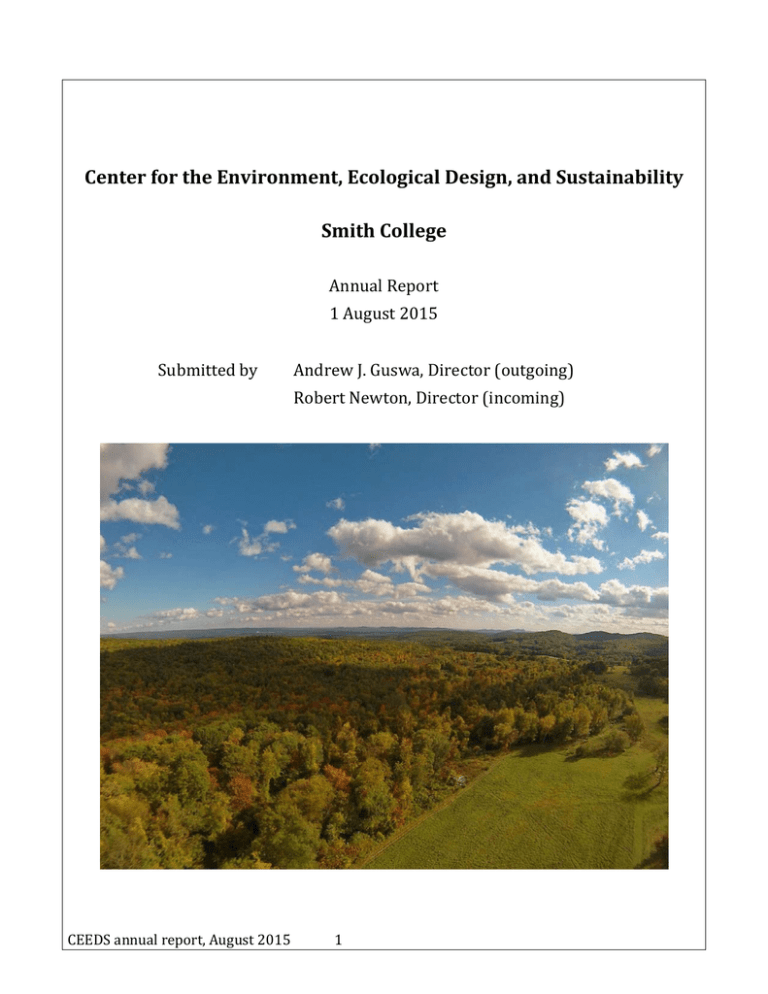
CenterfortheEnvironment,EcologicalDesign,andSustainability SmithCollege AnnualReport 1August2015 Submittedby AndrewJ.Guswa,Director(outgoing) RobertNewton,Director(incoming) CEEDSannualreport,August2015 1 ExecutiveSummary TheCenterfortheEnvironment,EcologicalDesign,andSustainability(CEEDS)preparesall Smith students to lead on issues of environment and sustainability. In 2014‐15, Smith College received $3.5 million in endowment support for CEEDS, solidifying its role in the educationofourstudents.Headingintothe2015‐16academicyear,wewillwelcomeand welcome back students who have never known a Smith without the Environmental Concentrations or the Bechtel Environmental Classroom. All of the CEEDS programs continuetogrowanddevelop,engagingmoreandmorestudentsfromacrossdisciplines. 2014‐15sawthelaunchofasecondEnvironmentalConcentrationonClimateChange,the opening of a low‐ropes challenge course at the MacLeish Field Station, updated environmentalmonitoring,innovativecurricularenhancementsacrosscampus,numerous fieldtripsforstudentsandfaculty,andopportunitiestoengagewithenvironmentalleaders througharangeofworkshopsandcolloquia.WealsowelcomedtoSmithDanoWeisbord, DirectorofCampusSustainability,andCamilleWashington‐Ottombre,assistantprofessorin Environmental Science and Policy, and we look forward to the arrival of Alex Barron, assistantprofessorinEnvironmentalScienceandPolicythissummer.On1July,Prof.Robert Newtonbeganhistermasdirector,andthissummerhehasworkedwithsixstudents,state regulators,andstafffromFacilitiesManagementtodevelopinnovativeandsustainableways ofmanagingthesedimentaccumulationinParadisePond. Regular operating expenses (including all salaries and compensation) during 2014‐2015, totaled$337,776andCEEDShadanadditionalexpenditureof$146,052ofone‐timefunds. 1 MissionandOutcomes Building on a strong tradition of women’s leadership at Smith, the Center for the Environment, Ecological Design, and Sustainability (CEEDS) brings together faculty, staff, and students from the natural sciences, social sciences and history, humanities, and engineeringtoaddressenvironmentalquestionsandchallenges.Ourmissionistograduate womenwhoexcelatintegratingknowledgetosupportenvironmentaldecisionsandactions. Thismission,andCEEDSitself,isintendedtocomplementandenhancethewiderangeof curricularpathwaysthatstudentscanchoosetostudytheenvironmentatSmith.CEEDSis aboutlinkingknowledgeacrosstheliberalartsandcriticallyapplyingthisknowledgetoreal‐ worldsolutions. Inpursuitofthesegoals,theactivitiesoftheCenteraredirectedtoward Enhancingthecurriculum Sponsoringintegrativeenvironmentalprojects Usingourcampusasamodelofsustainability Integratingenvironmentalresourcesandinformation Sections3through6ofthisreportareorganizedaccordingtothesecategorieswithdetails onspecificactivities. Cover photo: View of the MacLeish Field Station from a kite (photo credit: Reid Bertone‐ Johnson). CEEDSannualreport,August2015 2 CEEDSisdrivenbyeducationaloutcomesratherthanactivities;thatis,wechoosetofocus ontheimpactoftheCenter.Throughtheprograms,activities,andcollaborationsfacilitated andsupportedbytheCenter,weintendthatSmithstudentswhoengagewithCEEDSwill MakeConnections Studentsbringtogetherknowledgeanddatafromdifferentfieldswithintheunifyingcontext oftheenvironment. SeeMultiplePerspectives Studentslearntoseeenvironmentalissuesfrommultipleperspectivesbyinteractingwith faculty,staff,alumnae,otherstudents,andcommunitymemberswithdifferentbackgrounds, experiences,andknowledge. GetOutside Studentslearnfromthecommunitiesandbuiltandnaturallandscapesinwhichtheyliveand study. TakeAction Studentstakeonenvironmentalprojectsinsideandoutsideofthecurriculumanddrawupon theirliberalartseducationinpursuitoftheseprojects. CommunicateEffectively Studentsdevelopskillsinlisteningtoandcommunicatingwithotherstofacilitatedecisions andaction. BuildMeaningfulCareers Studentsfindmeaningfulinternshipsandemploymentinenvironmentalfieldsoverarange ofsectors(graduateschool,business,non‐profit,government). Additionally,asaresultoftheCenter’sexistence FacultyareSupported MembersofthefacultyuseCEEDSasaresourcetosupportandenhancetheirteachingand scholarship. AlumnaeConnect Smith alumnae connect with the college, current students, and each other to share knowledge,experiencesandexpertiserelatedtotheenvironmentandsustainability. SmithGainsRecognition Smith enhances its reputation as a model of environmental sustainability, as a place for studentstolivesustainably,andasoneofthebestplacestostudytheenvironment. SmithEvolves Innovative ideas that prove successful within CEEDS are adopted and implemented throughoutthecollege. CEEDSannualreport,August2015 3 2 GrowthandDevelopment TheroleofCEEDSintheeducationofSmithstudentscontinuestogrowanddevelop.During the2014‐2015year,CEEDSinteractedwiththousandsofpeople–fromstudentsandfaculty tocommunitymembersandlocalleaders.Ourenergiesweredirectedtowardsincreasing ourvisibilityandconnectionsoncampusandwithinthegreaterFiveCollegearea.Tothis end, the year saw collaborations deepen with a number of Smith offices and programs, several local non‐profit organizations, and members of the Five College consortium – Amherst,Hampshire,MountHolyoke,andUMASS‐Amherst. Image 2: CEEDS collaborated with Dining Services at this year’s annual Cider Pressing to offertastingsoflocalcheesesandheirloomapples. 2.1 Personnel Asof1July2015,theCEEDSstaffcomprisestheDirector,AssistantDirector,FieldStation Manager, Environmental Research Coordinator, and Administrative Assistant. EnvironmentalFellows,appointedfromtheSmithCollegefaculty,providestrategicguidance CEEDSannualreport,August2015 4 tothedirectorandstaffandactivelyadvanceCEEDSprograms.Separateadvisoryboards exist to set policy and make decisions related to the MacLeish Field Station and the EnvironmentalConcentrations.Table1providesalistofCEEDSstaffandaffiliatedfaculty. During 2014‐15, CEEDS also supported 7 student interns who engaged in a variety of projectsbothonandoffcampus.Withtheclosingofthe2014fiscalyear,AndrewGuswa’s termasDirectoroftheCentercametoanend.RobertNewtonbeganasthenewDirectorof CEEDSonJuly1,2015. Table1:CEEDSstaffandaffiliatedfaculty,2014‐15. Staff Director AndrewGuswa AssistantDirector JoanneBenkley FieldStationManager ReidBertone‐Johnson Env.ResearchCoordinator PaulWetzel AdministrativeAssistant SaraKirk EnvironmentalFellows JesseBellemare,BiologicalSciences,EnvironmentalScienceand Policy(ES&P) DanielGardner,History AnnLeone,FrenchandLandscapeStudies(LSS) JamesLowenthal,Astronomy AmyRhodes,Geosciences,ES&P L.DavidSmith,BiologicalSciences,ES&P MacLeishAdvisoryBoard AmyRhodes(Chair),Geosciences,ES&P JesseBellemare,BiologicalSciences,ES&P,LSS ReidBertone‐Johnson,CEEDS,LSS ScottJohnson,Athletics AndrewGuswa,exofficio AdvisoryBoardfor EnvironmentalConcentration: SustainableFood ElisabethArmstrong,StudyofWomenandGender JoanneBenkley,CEEDS BarbaraBrehm‐Curtis,ExerciseandSportStudies MichelleJoffroy,SpanishandPortuguese AnnLeone,French,LSS NancySternbach,SpanishandPortuguese PaulWetzel,CEEDS AndrewGuswa,Engineering,ES&P,LSS CEEDSannualreport,August2015 5 AdvisoryBoardfor EnvironmentalConcentration: ClimateChange JesseBellemare,BiologicalSciences,ES&P,LSS JoanneBenkley,CEEDS ElliotFratkin,Anthropology,ES&P NathanaelFortune,Physics DanielGardner,History AndrewGuswa,Engineering,ES&P,LSS AliceHearst,Government DanielleIgnace,BiologicalSciences,ES&P JamesLowenthal,Astronomy DeniseMcKahn,Engineering RobertNewton,Geosciences,ES&P AmyRhodes,Geosciences,ES&P SusanSayre,Economics,ES&P ElizabethSpelman,Philosophy GregoryWhite,Government,ES&P CEEDSannualreport,August2015 6 Thisspring,twoofGardner’sstudents,LeslieHillsamer’16andCaitlynVincent‘17,presented papersontheirworkattheBardCollegeAsia/EnvironmentStudentResearchConference. Gardnerhasalsobecomeasoughtafterexpertonthetopicandcontinuestopublishpieces regularly, because, as he says “it is essential that Americans understand something about China’senvironment,aboutpollution.Itisnotjusttheir(China’s)problem.It’sourproblem, too,sincemuchofitcomesfromthemanufacturingofexports,manyofwhichcometotheU.S. WeneedtorecognizethatwearecontributingtosmogandpollutioninChinabyourown consumption of goods. We cannot remain parochial in our views, and we cannot compartmentalizetheairwebreathe.”Gardnerwritesinlaytermsabouttheenvironmentin Chinaasawaytoinformothersand,intheprocess,learnmorehimself.Hehaswrittenop‐eds forpublicationsliketheLosAngelesTimes,theNewYorkTimes,TheGuardian,theChristian Science Monitor, and the International Herald Tribune. He has been interviewed by news outletslikeTheGuardian,ForeignPolicy,theNationalBureauofAsianResearch,RadioFree AsiaandVoiceofAmerica.HeisnowintheprocessofwritingabookforOxfordUniversity PressonenvironmentalpollutioninChina. 2.2 AlumnaeAdvisoryBoard The CEEDS alumnae advisory board sharestheir professional expertise andinsights with CEEDSstaffandEnvironmentalFellowsandinturnsharesourmissionandsuccesseswith alumnaeandexternalaudiences.Membershipcomprises: Donna Attanasio ‘81, Senior Advisor for Energy Law Programs at The George WashingtonUniversityLawSchool Katherine Borgen ’64, Board Chair of Rachel’s Network; Trustee, The Nature Conservancy(CO);Director,BorgenFamilyFoundation LeslieCarothers‘64,VisitingScholarattheEnvironmentalLawInstitute;member, BoardofDirectorsoftheCenterforClimateandEnergySolutions AiméeChristensen‘91,FounderandCEOofChristensenGlobalStrategies DeborahDuncan‘77,DirectorandSeniorAdvisorofFremontGroup;Trustee,Smith College IlonaJohnson‘06,AssociateLilkerEMOEnergySolutions Erinn McGurn ‘94, Co‐founder and Executive Director of SCALEAfrica; Owner/Principal of SCALEStudio; member, Board of Directors of the Alumnae AssociationofSmithCollege;member,STEMAdvisoryBoardforthePartnershipfor AfterSchoolEducation(PASE) Jan Van der Voort Portman ‘78, Trustee, The Nature Conservancy of Montana; HonoraryLifeTrustee,TheNatureConservancyofOhio;MemberoftheBoard,Rare TheAdvisoryBoardmetthisyearviaaSkypeconferencecalltodiscusstheongoingwork and goals of CEEDS. The next in‐person meetingwith the Board is scheduled for October 2015. CEEDSannualreport,August2015 7 2.3 GrantProposals,Gifts,andFundraising In2014‐2015,CEEDSstaff,inconjunctionwithSmith’sOfficeofDevelopmentandSponsored ResearchOffice,submittedtwograntproposalsinsupportofourprograms. Title: CommunityCenteredEnvironmentalProblemSolving:APilotProject Agency: ThoreauFoundation Amount: $35,000 Summary: Theultimategoalofthisprojectistochangethefocusofenvironmental educationatSmithCollegetowardsmoreexperiential,inquiry‐oriented, community‐basedstudies.EightstudentsfromSmithCollegewillwork withregulatorsandnonprofitenvironmentalgroupstodevelopinnovative methodsformanagingthesedimentsthataccumulatebehindsmalldams. Duringanintensive10‐weekprogramoverthesummerof2015,these studentswillmonitorandanalyzearangeofcontrolledexperimentsthat attempttoflushsedimentthroughthedamthatcreatesParadisePondon theMillRiver. Status: NotFunded Title: CenterfortheEnvironment,EcologicalDesignandSustainability Agency: Namewithhelduponrequest Amount: $200,000 Summary: SupportforoperationalandprogrammaticexpensesoftheCenterforthe Environment,EcologicalDesign,andSustainability. Status: Funded;1July2015–30June2016 Inadditiontothegrantproposals,theCenterfortheEnvironment,EcologicalDesign,and Sustainabilityalsoreceivedanumberofgiftsandcommitmentsfromalumnaeandfriends. Giftsgreaterthan$1000include Pledge/Giftamount Donor Intent $1million MarciaMacHarg‘70 $2.5million Anne (Attfield) Hubbard ’55 Endowment andTomHubbard $25,000 LynnDonaldson‘70 Currentuse $25,000 CameronScottAvery Currentuse $20,000 KatherineSharpeBorgen‘64 Currentuse $10,000 LoisPerelson‐Gross‘83 Currentuse $6,500 MaureenOgden‘50 Currentuse $2,000 WymandJanPortmanFund Currentuse CEEDSannualreport,August2015 8 Endowment $2,000 DonnaAttanasio‘81 Currentuse $1,000 ErinnMcGurn‘94 Currentuse 3 EnhancetheCurriculum 3.1 EnvironmentalConcentrations CEEDSofferstwoEnvironmentalConcentrationsthatprovideaframeworkforstudentsto integratetheiracademicandexperientiallearningaroundcross‐disciplinaryenvironmental topics: Climate Change and Sustainable Food. Each concentration comprises four components: a gateway course, core courses selected from across the five colleges in consultationwithafacultyadvisor,twopracticalexperiences,andaproject‐basedcapstone course.In2014‐15,24studentswereaffiliatedwithourEnvironmentalConcentrationsin SustainableFoodandClimateChange. 3.1.1 GatewayCourses Students choose between two gateway courses that present environmental issues from a range of perspectives: LSS 100, Landscape, Environment, and Design, and ENV 100, Environment and Sustainability: Notes from the Field. ENV 100 is a course organized by CEEDS staff that exposes students to real‐world practitioners in a broad range of environmentalfields. Thisyear,speakersinENV100rangedfromlocalfarmersgivingatouroftheirfarmtothe senior attorney and Director of the China Program for the National Resource Defense Council.The2014line‐upalsoincludedonealumna,RouwennaLamm‘08,whospokeabout herworkastheNationalProgramDirectorforAllianceforClimateEducation,anon–profit organizationfocusedoneducatinghighschoolstudentsaboutclimatechange.AppendixA providesacompletelistofthe2014‐2015ENV100andLSS100speakersandtheirlecture titles. 3.1.2 CapstoneProject:SustainableFood ThegoaloftheSustainableFoodcapstoneclassistoprovidestudentswiththeexperienceof working together on a real project. As a team, the class works with a “client” gathering information,conductingsurveys,creatingmaps,andeventuallymakingrecommendations. Throughoutthesemesterstudentsapplytheknowledgeandskillstheyhavelearnedduring theirtimeatSmithtowardtheirparticularproject.Invariably,theyalsolearnatremendous amountaboutteamwork,communication,projectmanagement,andmeetingacommongoal. Thisyear,inlightofthenewMassachusettsDepartmentofEnvironmentalProtectionbanon disposalofcommercialorganicwastesbyinstitutionsthatdisposeofmorethanonetonof thesematerialsperweek,studentsinthecapstoneclassinvestigatedtheCollege’ssystem fordisposingoffoodwaste.Thisincludedareviewoftheactualmaterialflowaswellasways toincreasestudentparticipationincompostingprograms.Thecapstoneclasstriedtore‐ envision“waste”atSmith.Theycollecteddataonthesizeoftheorganicwastestreamand lookedatallaspectsoftheorganicwastesystemfromfooddisplayandserving,packaging from condiments, and bulk purchasing. Students also considered high waste‐producing eatingoptionssuchasGrab‐n‐GodiningroomsandtheCampusCenterCafé. CEEDSannualreport,August2015 9 The students made several important conclusions from their investigations. One was the possible campus purchase and operation of an in‐vessel aerobic digester. Such a digester wouldreducedisposalfeesandallowthecompostingofsoyutensilsandpaperproducts, whilerecoveringthecapitalcostsofthedigesterinfouryears. The students also felt that one of the primary goals of the College should be to educate studentsinsustainablelifepractices.Theclasssuggestedthatsustainable‐livingeducation beginassoonasnewstudentsarriveduringorientationweek.Studentscouldbetrainedthen to use the composting system and other resource saving programs on campus. They reasonedthatSmith’slegacycouldonlybeenhancedbyusingthecampusasaclassroomand teaching students how to steward the resources that sustain them, thus making it more possible for graduates to fulfill their responsibilities to the local, national and global communitiesinwhichtheylive. Image3:Studentswentonamini‐retreatwithstafffromCEEDSandtheWurteleCenterfor Work and Life to reflect on their work and experiences within the Environmental Concentrations. 3.1.3 LinkingAcademicsandAction Anintegralpartoftheconcentrationsarethepracticalexperiencesthatthestudentstakeon. Thisyearourstudentstookpartininternshipswithsevendifferentorganizations,fromBook andPlowFarminAmherst,MAtoCornellUniversity’sMcKnightFoundationCollaborative Crop research Program in Ithaca, New York to the Third Millennium Alliance in Ecuador. Their work encompassed everything from maintaining a healthy aquaponics system to takingonthelogisticsofhigh‐volumefarmproductiontotestingsoilsamplestodeveloping and maintaining an online resource for researchers and development practitioners to helpingcreateanagriculturalandartisanalmarketplace.Seetheboxesbelowformore abouttheexperiencesoftwoofourstudents. CEEDSannualreport,August2015 10 TakingAction:SiiriBigalke‘16J SiiriBigalke‘16JworkedasaninternattheInterfaithCenterforSustainableDevelopment (ICSD) in Jerusalem. While there, Siiri worked on a host of projects with the diverse communitiesintheJerusalemareatopromoteenvironmentalsustainability.Herprimary projectwastohelpleadamonthlywomen’sinterfaith(Muslim,Christian,Jewish)meeting with the goal of empowering women to become community leaders and find common ground through a shared sense of environmental awareness and stewardship in their respectivefaiths. “Climatechangeisaverycomplexissue.Formeitisoftendifficulttoknow whichavenueIcantakeinordertopromotethemosteffectivechange.While my work at ICSD did not involve technical research about the impacts of climate change on theJerusalem community, it was nonetheless a growing experiencebecauseIwasabletoexperiencesustainabilitythroughdifferent religious and cultural lenses. I discovered that trying to build mutual understanding between Jerusalemites also builds respect for the environment. Thisexperiencetaughtmetheimportanceofusing“place”asatoolinorder topromoteunderstanding.InJerusalem,“place”isthesourceofallcontention in this city. Yet it also has huge potential to bring Israelis and Palestinians together–throughtheirmutualreverenceofthisHolyLand.Whenusingthe land and the environment as a springboard for understanding, it becomes evident that religious and cultural barriers do not exist when it comes to environmentalrespect.” Image4:Siiri,thirdfromleft,withsomeofherICSDcolleaguesinJerusalem. CEEDSannualreport,August2015 11 TakingAction:IsabelCochran‘15 IsabelCochran’15workedasaninternatEssexFarminEssex,NewYork.Whilethere, Isabel and her fellow interns experienced all of what is involved with running a diversified organic farm. Her daily work of animal/dairy chores and vegetable‐related tasksincludedmovinganimals,planting,weeding,harvesting,washing,slaughteringand more. “This experience was life changing for me. I learned more than I ever thoughtpossibleatafarm,wasexposedtosomanydifferentideas,metso manydifferentpeoplewhoarepassionateaboutagricultureandthinkand discuss critically how agriculture fits into addressing our current environmental problems. I learned to value the work that goes into producingmyownfoodandtovaluegoodfood.Inolongerwanttoeatfood that has been mass produced, severely adulterated, pumped full of chemicalsanddisrespected,becauseIknowthepleasureIfeelwhenIeat foodthathasbeenproducedwiththought,care,andrespect.Iknowthetoil thatwasrequiredforthefoodtoreachmyplate,andIknowthejoythat foodcanbringtopeople.Overall,IhavegreatrespectforthefoodIeat,a criticaleyeforchoosingthefoodIeat,arespectforhardphysicalwork,and anunderstandingthatfarmingisnotajobforthosewhoarenotwillingto workhardwhilethinkingevenharder.Farmingrequiresalotofknowledge, attention to detail, critical thinking, and ability to research.” Image5:Theonionharvestinthebarnafteralong,hardday’swork. CEEDSannualreport,August2015 12 3.2 EventsandWorkshops 3.2.1 ConcentrationEvents To complement our Environmental Concentrations, CEEDS hosts or co‐sponsors events related to the topics of sustainable food and climate change, and also helps support and promotesucheventswithintheFiveCollegeConsortium.Examplesfromthisacademicyear include: A workshop: “Re‐Storying the Land: Race, Place and Voice in America” on Otelia Cromwell Day that engaged students, faculty and staff in a conversation about the relationship between people, land, and place. Organized in partnership with the OteliaCromwellDayCommittee. A field trip for CEEDS staff and students in the SWG 230 Gender, Land and Food MovementclasstoparticipateintheRacialEquityintheFoodSystemgatheringin Holyoke,sponsoredbylocalorganizationPVGrows. Agleaningfieldtripincollaborationwithlocalorganization Rachel’sTableforthe secondyearinarow. A lecture: “Climate Justice and Indigenous Peoples: Moral, Cultural and EnvironmentalIssues,”byKyleWhite,assistantprofessorofphilosophyatMichigan StateUniversity,incollaborationwiththephilosophydepartment. A lunchtime conversation: “Equal Exchange and Working for Sustainable Food SystemswithalumnaGabrielladellaCroce,’12.Gabriella,whohasbeenworkingin the sustainable food field primarily in Central America, returned to campus in an eventco‐sponsoredwiththeCenterforCommunityCollaboration. A lecture: “Methane Emissions Make a Natural Gas Bridge to Nowhere,” by Bob Howarth,abiogeochemistatCornellUniversitywhohaswrittenseveralpapersabout greenhouse gas emissions associated with natural gas extraction by hydraulic fracturing.CEEDScollaboratedwiththegeologydepartment(aspartofthe5‐College geosciencelectureseries)andES&P. AhydroponicsworkshopandlecturebyDr.MartinSchreibman,incollaborationwith theSmithstudentchapterofEngineersforaSustainableWorld. Performances of “Vang” and “ Map of My Kingdom”, two one‐act plays by Mary Swander,PoetLaureateofIowa,incollaborationwithUMASSArtsCouncil,UMASS Student Farming Enterprise, and the UMASS departments of English, resource economics,andcommunications. CEEDSannualreport,August2014 13 The2014People’sClimateMarch Some60Smithstudents,staff,andfacultyjoinedwithover400,000othersinthePeople’s ClimateMarchinNewYorkCityonSeptember21st.Thatday,twodaysbeforethescheduled UnitedNationsClimateSummit,millionsofpeoplearoundtheworldgatheredatmorethan 2,000ralliesin162countriestodemandactionfromtheirleadersonclimatechange.The Smithstudentswhoparticipatedwereadiversegroup:theycamefromacrossthecollege, andincludedstudentsfromeveryclassyearandfrommajorsacrossallthedivisions.With thesupportofCEEDS,studentstooktheleadontheplanningandorganizingforthiseffort, whichincludedcoordinatingwithcommunityandnationalorganizations.Asadirectresult ofthisworkandtheeventitself,studentsmadeconnections‐betweenthevariedindividual issuesthattheycaredabout(e.g.sustainableagriculture,foodaccess,tribalrights,fracking) and the larger issue of climate change; students took action and had to communicate effectivelyinsomanyways‐beingpresentandspeakingup,andonsuchascaleandwithso manyothersenergizedandrechargedeveryonesotheyfelttheycouldcomebacktoSmith and continue to learn and work on solutions to environmental issues without feeling overwhelmed and hopeless about the future. See the [CEEDS] blog post about this: http://smithceeds.wordpress.com/2014/09/23/from‐apple‐orchards‐to‐the‐big‐apple‐ smith‐students‐take‐to‐the‐streets/ Image6:SomeofthemanySmithiesatthePeople’sClimateMarch. 3.2.2 OtherEvents,Lectures,andFieldTrips CEEDSalsohostsorco‐hostsnumerousengagingspeakersandeventsduringtheyear.Some examplesfrom2014‐15include: Apanel:UnitingthePlanet:BringingFaith,ScienceandCommunityOrganizing LeadersTogethertoPromoteEnvironmentalJustice AlunchbagconversationwithBarbaraFinamore,seniorattorneyandAsiaDirector, ChinaProgram,NaturalResourcesDefenseCouncil. CEEDSannualreport,August2015 14 AnaturewritingworkshopwithpoetandwriterAllisonDemingattheMacLeish FieldStation,co‐sponsoredwiththePoetryCenter. Alecture:“TheEndofNight,”byPaulBogard,professorofEnglishfromJames MadisonUniversity,incollaborationwiththeastronomydepartmentandtheCityof Northampton,withsupportfromtheCollege’sendowedlecturefunds. Alecture:“RadicalListening:ADoctor’sExperienceSavingLivesandRainForestin IndonesianBorneo”byDr.KinariWebb,incollaborationwithES&Pandthepre‐ healthprogram. AconversationbetweenstudentsandJeffreySachs,economist,directorofTheEarth Institute,QueteletProfessorofSustainableDevelopment,andProfessorofHealth PolicyandManagementatColumbiaUniversitywhilehewasoncampusforhis lecture“TheAgeofSustainableDevelopment,”aspartofthePresidential ColloquiumSeries. AseriesofeventsduringEarthWeekrelatedtothetheme“ParadiseatSmith: CelebratingourWaterfront;EmbracingourWatershed.” AstaffandfacultydevelopmentfieldtriptotheDeerIslandwastewatertreatment facilityinBostonHarbor. 3.2.3 IntertermWorkshops ReidBertone‐JohnsonandCarolBerner(fromEducationandChildStudy)taughtLSS110J: Interpreting the New England Landscape for one week of Interterm. This course, which startedasanon‐creditcourseinJanuaryof2014,wasapprovedforcreditthisyearbythe CommitteeonAcademicPriorities.SixteenstudentsenrolledintheJanuary2015course. StudentstookanaturalhistorywalkguidedbyPaulWetzel,andlearnedaboutthecultural historyofthesiteandregionfrombiologicalsciencesprofessor,JesseBellemare.Students alsolearnedabouttheprocessandpoliciesofLivingBuildingChallenge(LBC)andworked withReidBertone‐JohnsontounderstandthenuancesoftheLBCandthewaysinwhichit continues to influence work at Smith College. The class then engaged in visual thinking strategieswithMaggieLindfromtheSmithCollegeMuseumofArt,tolearnnewwaystohelp visitors interpret what they see in the landscape, and they worked with Carol Berner to practiceandprepareactivitiesforvisitorstoexperienceaspartoflearningaboutthefield station. On the last day of the course, 40 sixth graders from the Smith College Campus School participatedinactivitiescreatedbytheSmithstudents,introducingthemtothenaturaland cultural history of the field station and to the Living Building Challenge. They tracked animals,usedvisualthinkingstrategiestointerprettheirenvironment,andexploredoneof themostsustainablybuiltbuildingsintheworld. CEEDSannualreport,August2015 15 Image7:StudentsfromLSS110Jexperiencingthelandscapeinanewway. 3.3 CurricularEnhancementGrants Each year CEEDS invites proposals from faculty for modifications and enhancements of existing courses that are congruent with the CEEDS mission. Over the past five academic yearsCEEDShassupportedtwenty‐fivefacultymembersfromacrossallacademicdivisions astheyhaveenhancedtheircoursestoenabletheirstudentstoengagewiththeenvironment in new and innovative ways. For 2015‐16, we are sponsoring four projects by faculty in chemistry, engineering, geosciences, and Spanish and Portuguese. Appendix B provides descriptionsofalloftheprojectsfundedthusfar. CEEDSannualreport,August2015 16 StudentsGetOutside:CurricularEnhancementGrantsinAction ProfessorsAmyRhodesandMichaelBarresiworkedtogethertodevelopresearch‐based courses that addressed water quality issues related to extraction of natural gas by hydraulicfracturingmethods,alsoknownas“fracking.”Theirgoalsweretocharacterize the chemistry and potential biological toxicity of surface waters (streams and a lake) locatedproximaltofrackingactivities.GEO301measuredtheinorganicgeochemistryand stableisotopiccompositionofthesampledwaters.BIO159Yisolatedallorganicsfrom thesampledwatersandusedthezebrafishmodelsystemtoassesswhetherthesepurified compoundscouldaffectembryonicdevelopmentaswellasactivateestrogenicsignaling intheembryo. ThestudysitefortheclasseswasarurallocationinnortheasternPennsylvania(Fiddle Lake, Ararat Township, Susquehanna County) where natural gas development of the MarcellusShaleisatpreliminarystagesofdevelopment.Theclassessampledbothwithin watersheds where shale gas extraction pads were constructed (but with no drilling activity), and within watersheds where development for shale gas extraction had not occurred.Followingthefieldtrip,thestudentsanalyzedtheirsamplesintheCenterfor AqueousBiogeochemicalResearch(CABR)andtheZebrafishResearchCenter.Theresults helpedcharacterizethebaselinewaterqualityandenvironmentaltoxicityconditionsfor the streams outside of drilling areas, which included identification of nonpoint source pollution already present and its effects on embryonic zebrafish development and endocrinedisruption.Inaddition,theyaimedtoseeifwaterqualityconditionsofstreams proximaltofrackingdifferedfromthebaselineconditions.Studentsineachcoursewere invested and interested in learning the results and interpretation generated by both classes and subsequently presented posters of their results at the Life Sciences SymposiumforCourse‐BasedResearch. CEEDSannualreport,August2015 17 ConnectionsAreMade:CurricularEnhancementGrantsinAction LaboratoryinstructorJanVriezenmodifiedhisbiologycourse,BIO205:Introductionto Microbiology, to include data from the MacLeish Field Station. Traditionally, this is a courseinwhichstudentscharacterizebacteriathatareunknowntothembutknownto theinstructor.Whileapositivelearningexperience,theeducationalvalueislimiteddue to the constraints of the approach itself: the unknowns are not really unknown. This conundrumiseasilysolvedbyallowingstudentstocharacterizebacteriatheydiscover themselves. In the modified course, students isolated soil bacteria from MacLeish for characterization in the lab. Relevancy was added by implementing the Small World Initiative,anationalattempttofindandcharacterizeantibioticproducingbacteria.This meantthatstudentsdidnotjustcharacterizeabacterialisolate,theygottocharacterize bacterialstrainsthatinhibitindicatorlawns,indicativefortheproductionofatoxin.For theirindicatorlawn,studentscouldchoosebetweenseveralbacteriathatareharmless relativesofpathogens.UsingsoilfromtheFieldStationprovidedawonderfulopportunity todohypothesistestingandpredictthat:(1)themicrobialloadishigherinrichrather thaninpoorsoil,(2)thenumberofbacteriathatinhibitanindicatorlawnishigherinpoor soils where it is more beneficial to produce antibiotics, and (3) due to the absence of predominantgroups,thediversityishigherinthosepoorsoils. Image8:StudentsfromBIO205collectingsamplesthroughlayersofsnowatMacLeish. The experience testing the hypothesis was astonishingly positive. As hypothesized, preliminarydatashowsthatthebacterialloadishigheringrasslandthaninforestland. Thenumberofantibioticproducingbacteriadependsontheindicatorlawnpointingat nichespecificityofcertainantibioticproducers.Italsoappearsthatatanyspecificsite, thepattern“top”vs“deep”isreversedforEscherichiacoliandStaphylococcusepidermidis. ForE.coli,samplingdeeperwillincreasethefrequencyofantibioticproducers,whilefor S. epidermidis this is reversed. Interestingly, this pattern is seen in forest as well as grassland samples. Those results were unexpected. Some isolates were further CEEDSannualreport,August2015 18 characterized, first using 16S rDNA sequencing, and later employing bacteriological techniques. This indicated that the diversity of antibiotic producers was highest in grasslandtopsoil,andlowestindeepforestsoil,differentfromourhypotheses. Pedagogicallytheapproachtakenwasalsoverysatisfying.First,beingaresearchbased course,assignmentssuchaskeepingalab‐notebookareveryimportant.Inaddition,the factthata‐priorisethypothesesmaynotbecorrectandthatintellectualre‐adjustmentis requiredisforeigntomanystudents.Withthecorrecthypothesisthereisnofailing,just learning. Also, because all isolates were unknown, students could not explain their “unexplainables”asincorrecttesting.Manystudentshadnothadtheseexperiencesinthe past.Mostimportantly,becausethestudentsdiscoveredtheirstrainsthemselves,andthe projectwasopen‐ended,projectownershipincreasedandthestudentsdeliveredmuch higherqualityworkintheformofverygoodreportsandpresentations. 3.4 EnvironmentalMonitoring To support research and understanding in the environmental sciences and improve quantitative literacy among all students at Smith College, the Center supports an environmentalmonitoringprogram.QuantitativedataontheenvironmentsaroundSmith aremadeavailabletofacultyandstudentsforuseincoursesandprojects.AttheMacLeish FieldStation,wecontinuouslymeasureprecipitation,temperature,atmosphericpressure, relative humidity, wind speed and direction, solar radiation, and soil temperature. The instrumentationanddatacollectionatbothweatherstationswereupgradedthisyear.The CenteralsopublishedthefirstAnnualWeatherReportsfromtheMacLeishFieldStationfor 2013and2014(seestorybelow). CEEDS also supported several field projects with our Distributed Temperature Systems (DTS).Theseinstrumentsusefiber‐opticcablestomeasuretemperatureevery25cmevery minuteforupto8km.Thecablescanbeputinstreams,buriedintheground,placedintree canopies,locatedinbuildings,ortowedthroughtheocean.DTSinstrumentswereusedto measure groundwater inflow along a kilometer of Avery Brook in support of a project overseenbyRobertNewton(geosciences).AsecondDTSdeploymentwasusedtomeasure forestfloortemperaturespriortoleafoutandjustafterleafoutinastudyoftheeffectsof climate change on Bazzania species of moss (overseen by Jesse Bellemare, biological sciences). Each of these projects involved Smith students in some aspect of the data collectionoranalyses,providingthemwithhands‐onexperiencetothisnovelmonitoring technology. CEEDSannualreport,August2015 19 CommunicatingEffectively:AnnualWeatherReports The weather stations at MacLeish measure the weather every second, average that informationevery10minutesandrecordit.That’salotofnumbersandnoteveryoneneeds somuchinformation.Forthosewhowanttoknowthehighsandlowsandgeneraltrends, CEEDS produced annual weather reports for 2013 and 2014. Think of them as weather picturebooks.EnvironmentalMonitoringIntern,IsabelCochran’15,calculatedthereport statisticsandcreatedthemonthlysummaries.Afewweatherhighlightsarelistedbelow;to view or download the full weather reports, please visit our website: http://www.smith.edu/ceeds/macleish_monitoring.php. 2013 2014 HighestTemperature(°C) 34.9(July17th) 31.6(July23rd) LowestTemperature(°C) ‐20.2(Jan.24th) ‐21.4(Jan.6th) Greatest Maximum Rain 85.1(July23rd) Event(mm) 92.7(Aug.13th) AnnualPrecipitation(mm) 1305.2 1348.1 GrowingSeason(days) 188 184 FirstAutumnFreezeDate October26th October19th LastSpringFreezeDate April21st April18th Image9:EnvironmentalMonitoringInternIsabelCochran’15inthefield. CEEDSannualreport,August2015 20 4 SupportingProjects One of the key activities for the Center is the sponsorship of integrative environmental projects in which students, faculty and staff work together toward solutions to environmentalchallenges.Currently,studentsareworkingonlocalprojectsrelatedtothe American chestnut restoration, sustainable watersheds and waterways, and the invasive hemlockwoollyadelgid. 4.1 SustainableWatershedsandWaterways WithgeneroussupportfromtheStephenBechtelFund,CEEDSsupportedarangeof projectsrelatedtoSustainableWatershedsandWaterwaysin2014‐15.Prof.Robert Newton(geosciences)workedwithfivestudentsandMr.GaryHartwellfromFacilities ManagementfromMaythroughJulytoinvestigatethepotentialforflushingsediments fromParadisePond.Alldamsdisrupttheflowofriverscausingsedimenttoaccumulatein theirimpoundments,and,unlessthissedimentisremoved,theywilleventuallybecome filled.Incontrasttodredgingthepondduringlowflows,theSmithteamisworkingwith stateregulatorstodeterminethefeasibilityofflushingsedimentthroughthedamand downstreamduringhighflows–aprocessthatmorecloselymatchessedimentmovement inanaturalchannel. Image10:AerialviewofsedimentaccumulationinParadisePondtakenbyaSpatialAnalysis Labdrone. ProfessorsCarolBernerandAlRudnitskyfromtheEducationandChildStudydepartment, workingwithonegraduateandthreeundergraduateSmithstudents,areleadingayear‐long series of workshops to engage local elementary school teachers in learning about how to incorporatewatershedsandwaterwaysintotheirregularclassroomteaching.Theteachers willcometogethertolearnfromeachother,developcurriculaandsharematerials. CEEDSannualreport,August2015 21 OnMay6,CEEDSsponsoredafieldtriptotheDeerIslandwastewatertreatmentfacilityin Boston. Sixteen faculty and staff engaged with Charlie Tyler, Program Manager for the MWRA,andPeterShelley,PresidentoftheConservationLawFoundation,gaininginsightto thelegalactions,politics,economics,historyandengineeringofthesuccessfulclean‐upof BostonHarborinthelate1990s. 4.2 AmericanChestnutRestoration Toengagestudentswithconceptsofconservationandrestoration,CEEDShascollaborated with The American Chestnut Foundation (TACF) for the past three years to establish an American chestnut seed orchard at the MacLeish Field Station. The purpose of the seed orchardistogrowupthelast(5th)generationofcross‐bredchestnutstoproduceblight‐ resistant hybrid nuts. The resulting 6th‐generation hybrid trees will have 94% American chestnut genes and 6% Chinese chestnut genes. This year, approximately 600 American chestnuthybridnutswereplantedintheseedorchardtoreplacenutsthatdidnotsurvive lastyear’splanting.Twelvestudentsspentatotalof40hoursassistingPaulWetzelandtwo membersofTheAmericanChestnutFoundation,BrianClarkandDenisMelican.Additional nutswillbeplantednextyearastheybecomeavailablefromthebreedingorchardsinthe region.Thenutsthatwereplantedwillbeallowedtogrowforthreeyearsbeforetheyare intentionallyexposedtothefungalblight.Ofthe1200totaltreesplanted,approximately20 areexpectedtoshowresistanceandgrowtomaturity.Thenutsfromthoseblight‐resistant treesproducewillthenbedistributedthroughouttheNortheast. Image11:Paulwiththeeducationalsignnearthesnow‐coveredAmericanChestnutseed orchard. CEEDSannualreport,August2015 22 4.3 HemlockWoollyAdelgid ResearchonthehemlockforestecosystemsatMacLeishFieldStationcontinuedin2014‐15, withmembersoftheBellemare(BIO),Rhodes(GEO),andIgnace(BIO)labsparticipatingin field research exploring a range of ecological, biogeochemical, and ecosystem‐level questions.ThehemlockforestsatMacLeishandinthesurroundinglandscapearecurrently underthreatfromtwoexoticinsectspecies,thehemlockwoollyadelgidandtheelongate hemlock scale. Both insects were accidentally introduced from East Asia to Eastern U.S. forests during the 20th century. In their native ranges, these insects co‐exist with Asian hemlockspecies,buttheEasternhemlocknativetoNewEnglandandtheEasternU.S.does not have resistance to their feeding, and large insect populations rapidly build up on the needlesandsmalltwigsofinfestedhemlocktrees.Thiscausesneedlelossand,eventually, treedeclineanddeath.AlthoughrelativelyfewtreesatMacLeishhavediedfromtheinvasive insectsto‐date,areasfurthersouthinNewEnglandandinotherpartsoftheEasternU.S. haveseenhighhemlockmortalityinthelast1‐2decades. With the decline of hemlock, the forest ecosystem is expected to change dramatically ‐ hemlockisaslow‐growing,evergreenconiferousspeciesthatcreatescool,shadyconditions underitscanopies,whileitistypicallyreplacedbyfast‐growingdeciduoustrees,likebirches, when it dies. This shift in forest composition has been linked to changes in ecosystem processes,suchashownutrientscyclethroughforests,andalterationofplantandanimal communitiesintheforestunderstory.TheongoingresearchatMacLeishseekstodocument how our hemlock forests are currently functioning and what biodiversity they sustain in advanceoftheexpectedlossofhemlocktreesincomingyears. StudentresearchinthelabofJesseBellemare,ledbyElizabethBesozzi'16,hascompared forestflooranimalcommunitiesbetweenadjacentpatchesofhemlockandbirch‐dominated forest at MacLeish to explore how animal communities might change with the loss of hemlock. This work has documented higher abundances of red backed salamanders, an important"keystonespecies"inforestfloorfoodchains,inthehemlockforests.Inaparallel project, Michelle Jackson '15 has experimentally tested how a small‐statured understory plantspecieslinkedtohemlockforests,theliverwortBazzaniatrilobata,mightfareifthe forestoverheadshiftstodeciduoustreeswithmorelightanddrierconditionsontheground. Resultstodatesuggestthattheliverwortmightdeclinealongsidehemlock,astheunique coolandlow‐lightenvironmentalconditionscreatedbytheevergreencanopyofhemlock appeartobenecessaryfortheplants'survival.Morebroadly,AlizaFassler'17,hasledwork surveying how organic material accumulates on the forest floor under hemlock versus deciduousforestcanopies,withresultsto‐datesuggestingamuchgreaterquantityoforganic materialandcarbonstoredintheforestfloorsofhemlockecosystems.Thisindicatesthat thelossofhemlockfromtheseecosystemsmighttriggerareleaseofcarbonfromtheforests aswell,astheorganicmaterialappearslikelytodecomposeandreleasecarbondioxideas conditionschangeintheunderstorywithlossofevergreencanopy. New workby students in Danielle Ignace's lab in the department of biology is seekingto betterdocumenthowthisdecompositiontakesplaceandunderwhatconditions,usingLiCor technology to directly measure carbon dioxide release from the forest floor. Elizabeth, Michelle, and Aliza, along with a number of their student collaborators and coauthors, presented the results of their MacLeish‐based work at Smith College's Celebrating Collaborationssciencepostersession,andalsobroughttheirposterstoabroaderregional audienceattheNortheastNaturalHistoryConferenceinSpringfield,MAinApril. CEEDSannualreport,August2015 23 Image12:HemlockbranchwithconesattheMacLeishFieldStation. 5 CampusasaModel 5.1 AdaandArchibaldMacLeishFieldStation The Ada and Archibald MacLeish Field Station is a 240‐acre patchwork of forest and farmlandlocatedinWestWhately,MAthatprovidesopportunitiesforfacultyandstudents topursueenvironmentalresearch,outdooreducation,andlow‐impactrecreation.[See6.4 for more information on outdoor education]. The field station now includes a student‐ designedfruitorchard,arestorationchestnutorchardaffiliatedwiththeAmericanChestnut Foundation, a low‐ropes challenge course, and four miles of student‐designed and built trails. More than 1,600 total visits to the field station by students, faculty, staff, and non‐Smith affiliatedcommunitymemberswererecordedin2014‐15.Twenty‐fourclassesfromSmith visitedasapartoftheircoursework,totalingcloseto500students.Amongthesevisitors were 30 environmental professionals from Central and South America visiting UMass, a collectionofeightcampussustainabilityfolksonaconferencefieldtrip,andmorethan400 peopleusingthenewchallengecourse.Additionally,hundredsofstudentshaveengagedin research, used the site as inspiration, participated in site‐specific design, gone on guided tours,andusedtherecreationaltrails.AppendixClistsallofthecoursesatSmiththatused theFieldStationthisyear. 5.2 CampusSustainability TheOfficeofCampusSustainability(OCS)wentthroughatransitionthispastyearwitha changeinleadershipandexpansioninstaffing.DanoWeisbordwashiredastheDirectorof CampusSustainabilityandSpacePlanningandEmmaKerrwashiredtofillanewCampus SustainabilityCoordinatorposition.OCSstaffspenttheyearstrengtheningtheHouseEco‐ Reps program, working with students on special studies to integrate their research into CEEDSannualreport,August2015 24 campus operations, and building partnerships with Facilities Management and the operationalsideofthecampus.Throughoutthistime,CEEDSstaffcontinuedtoworkwith theofficetodevelopprogramsandprojectsthatlinktheCenterwithSmith’soperationsand tofacilitatefacultyandstudentresearchcollaborationsthatfurtherthemissionoftheOCS. Forexample,thisfallPaulWetzelandstudentsintheenvironmentalconcentrationcapstone classworkedcloselywithDanoontheirprojecttoevaluatethequantityofSmith’sorganic wasteandtechnologytomanagethatwaste.IncollaborationwiththeOCS,thisprojectwill continue with students in the 2015 capstone working to expand the analysis, look at potentialcommunitypartners,exploredifferenttechnologies,andanswerquestionsabout Smith’sclimatefootprint. Inaddition,Pauladvisedtwosustainablefoodconcentrationstudents,LilyCarlisle‐Reske ’17andClaireWesta’17,inaspecialstudiesthatinvestigatedthepossibilityoftheCollege committingtotheRealFoodChallenge.TheRealFoodChallengeisacampaigntoshift$1 billionofexistinguniversitybudgetsawayfromindustrialfarmsandjunkfoodandtowards local/community‐based,fair,ecologicallysoundandhumanesources‐whattheycall“real food”‐ by 2020. During the fall semester, Lily and Claire worked closely with Franny Krushinsky, the new Sustainability and Culinary Manager in Dining Services, to comprehensivelyevaluatehowmuch“realfood”DiningServicescurrentlyuses.Theirwork directlysupportstheongoingeffortsofSmithCollegeDiningServicestodevelopsustainable, localandhealthyfoodpractices,effortsthatthisyearhavebeenfundedbyatwo‐yeargrant fromtheHenryP.KendallFoundation. Eatingfoodalwaysinvolvesleftovervaluableorganicresources.Thisspring,Pauladvised EleanorAdachi’17inaspecialstudiesprojecttoconductasystemanalysisofcompostingin student houses. Eleanor gathered data through surveys and “trash” audits. She estimated thatacompostingprograminthehouseswoulddivert26‐39tonsoforganicmatterannually fromthelandfill. CEEDS has continued to lead conversations with Facilities Management regarding the efficientandeffectiveuseofCollegevehicles.CEEDSoffsetsitscarbonemissionsfortravel eachyear,andthisyearCEEDSpurchasedoffsetsequivalenttofivemetrictonsfromTerra Pass. 6 CommunicationandCollaboration CEEDSisrecognizedasanimportantresourceforcollaborationandtheplacetocomefor informationabouttheenvironmentatSmith.CEEDSstaffmembersconnectstudents,faculty, andvisitorstoenvironmentalorganizationsinourcommunityandresourcesrelatedtothe curriculum,projects,operationsandfacilitiesatSmith.Thiscentralizationisofgreatvalue to our community and helps to reinforce Smith’s commitment to the environment and sustainability. 6.1 CEEDSBlogandOtherMedia CEEDShasapproximately390fansonFacebook(www.facebook.com/pages/Smith‐College‐ Center‐for‐the‐Environment‐CEEDS/) and our posts regularly reach as many as 2,000 people.Wenowhave184followersonTwitter(@SmithCEEDS),andwecontinuetotweet aboutouraccomplishments,ourevents,andrelatednewsitems.Approximately500people regularly read our blog [CEEDS] (smithceeds.wordpress.com), which has become an increasinglycollaborativeendeavor.Wecontinuetoencouragestudentsandfacultyengaged CEEDSannualreport,August2015 25 in environmental work of all sorts, both on and off campus, to use our social media connectionsasameansofsharingtheirexperienceswiththelargerSmithcommunity.With the help of student interns, CEEDS manages an email ListServ [ENVIRO], which provides current students (570+), alumnae (330+), and interested faculty/staff (80+) with information about events, internships, job opportunities, graduate schools, funding and more.ThisyearOdessaAguirre’15andLilyCarlisle‐Reske’17workedasCEEDSinternsto supportouroutreachandcommunicationefforts. 6.2 SupportingStudentsandStudentOrganizations Thisyear,CEEDSworkedwithindividualstudentsandstudentorganizationstoco‐hostand supportavarietyofevents.CEEDScontinuedtoprovidesupportand/orameetingandevent space for the Community Garden, Eco‐Reps, Green Team, Divest Smith College, and EngineersforaSustainableWorld. CEEDSsupportedMadeleineLifsey'15inherspecialstudies"AnimalAgricultureandthe Philosophy of Sustainability" with the philosophy department. During the fall semester, Madeleineinterrogatedthewaysinwhichcurrentenvironmentalethicsandenvironmental sustainabilitydiscoursecanworkwithandagainstvariousformsofanimalagriculture. CEEDSfacilitatedstudentparticipationintheWomen'sCleanEnergyInternSocialhostedby the Massachusetts Clean Energy Center (MassCEC), a night of networking with leading women in the clean energy industry, including MassCEC's CEO, Alicia Barton. Student participantsincludedAlisonGrady'15,NicoleDeChello'15,MayaKutz'15,IsabellaCasini '17,YoungjooAhn'18,HattieSchapiro'18,andIzzyOwen'18. CEEDS supported Alexandra Davis '18 and Jessica Tran '18 in attending the Net Impact ConferenceinMinneapolis,MN.AlexandraandJessicaarecurrentlyexploringwhetherthere isenoughinteresttolaunchaSmithNetImpactchapter. CEEDS is again supporting a summer intern to work in the Smith Community Garden as SummerManager.InadditiontobloggingforCEEDS,studentDanielleJacques‘16willhost weedwalksandworkparties,worktore‐configuredthegardencompostingsystem,improve signage,workwithDiningServicesstafftoprovidefreshproducefortheCampusCenterand engagedstudents,facultyandstaffoncampusforthesummerintheworkofthegarden. 6.3 AlumnaeOutreach Throughout 2014‐2015, CEEDS staff and Environmental Faculty Fellows worked closely withEnvironmentalScienceandPolicy,LandscapeStudies,andtheAlumnaeAssociationto sharethemissionandpotentialofenvironmentalprogramsatSmithwithalumnae,friends, andpotentialdonors. Specificeventsfor2014‐15include: January2015Dinner,breakfast,andconversationswithMarciaMacHarg’70. March 2015, “Iceland’s Volcanoes: A Hotspot of Volcanic Activity”, presentation by Amy RhodesduringaSmithAlumnaetriptoIceland. May2015,“Water,Food,andClimate–LeadershipforaSustainableWorld,”presentationby AndrewGuswaduringReunionweekends(1stand2nd). May2015,WalkingtourofthehistoricMillRiver,ledbyAndrewGuswaduring2ndReunion weekend. CEEDSannualreport,August2015 26 May2015,AndrewGuswawasthedinnerspeakerfortheClassof1970reunion. Image13:AlumnaoncampusforreunionfillCEEDStolearnmoreaboutissuesofwater,food andclimatefromdirectorAndrewGuswa. 6.4 SpatialAnalysisLab The Spatial Analysis Lab is a campus‐wide resource that supports the use of geographic informationsystems(GIS)andvariousformsofspatialanalysisinresearchandcourses.As nearlyallenvironmentalissuesinvolveageographiccomponent,theresourcesoftheSAL areintegraltotheworkofCEEDS.TheSALcuratesanddisseminatesGISdataandteaches GPS and GIS skills to Smith faculty, staff, and students. For example, students have used TrimbleGPSunitstomapdataontheAmericanchestnutandfruittreegrovesatMacLeish, to map the movement of local invasive plant species, and to continue work on ongoing projectsalongtheMillRiver.AvailabilityofGeospatialPositioningSystems(GPS)andthe support and expertise that the SAL provides for collecting and managing data remains invaluabletotheworkofCEEDSanditscommunitypartners. In 2014‐15, CEEDS financially supported the post‐baccalaureate position in the SAL. This staffpositionbenefitsfacultyandstudentsacrossthedivisions,and,inadditiontoclassand researchsupport,allowstheSALtoofferworkshopsandtimelyopportunitiesfortheSmith communitytoengagewithreal‐worldissues,liketheEbolacrisisinAfricaortheearthquake inNepal. 6.5 OutdoorEducation High5AdventurecompletedconstructionofSmith’slow‐ropeschallengecourseinlateJuly of2014.Twoweekslater,thirteenSmithfacultyandstaffparticipatedinaworkshopledby High5AdventureLearningCenterstafftolearntobefacilitatorsonthechallengecourse. CEEDSannualreport,August2015 27 Withinonlyafewweeksofthattraining,morethan200students(primarilyResidenceLife staff) experienced thechallenge course firsthand, and they were quickly followed bythe Student Government Association, house councils, several athletic teams, the Outdoor AdventurePrograms,and other classes. Seventy students participated in activities onthe challengecourseonMountainDayalone. Image14:StudentsfromEmersonHouseworktogetherontheAround‐the‐Worldelement. Additionalstudentsandstaffhavejustcompletedanotherroundoffacilitatortrainingonthe challenge course and look forward to providing opportunities for even more students to benefitfromtheleadershipdevelopment,teambonding,andgeneralfunthatthecoursecan provide. CEEDS anticipates increased use by Summer Programs at Smith as well as the incorporationofthechallengecourseintoorientationandleadershipprogramsofferedby theOutdoorAdventureProgram. 6.6 Five‐CollegeCollaboration Withatwo‐yeargrantfromtheMellonFoundation,administeredthroughFiveColleges,Inc., CEEDS collaborated with environmental programs from Amherst, Hampshire, Mount HolyokeandtheUniversityofMassachusettstoawardfacultygrantsinsupportofbridging theliberalartsandprofessionalprogramsinenvironmentalfields.Projectsrangedfromco‐ teachingofcoursestoembeddingprofessionalmaster’sstudentsinclassesattheliberalarts colleges.In2014‐15,thegrantsupportedfourcollaborations. RobertRyan,ProfessorintheDepartmentofLandscapeArchitectureandRegionalPlanning at UMass partnered with Michele Wick, lecturer in the Psychology Department at Smith College,onacourseongreeninfrastructure.Twenty‐oneundergraduatesandthreegraduate CEEDSannualreport,August2015 28 students drew on literature and research from the behavioral sciences to inform their designsforasustainablecampus. GraduatestudentSuzanneCoxjoinedProfessorKateBallantinetoteachRestorationEcology atMountHolyoke.Suzanne’sexperiencewithlarge‐scaleconstructionprojects(contractors, permits,inspectors)contributedanapplication‐orientedperspectivetothecourse. Profs.ChristineHatch(UMass)andKateBallantine(MountHolyoke)broughttogethertheir classesonEcohydrologyandWetlandsEcologyandManagement,respectively,toconnect undergraduate and professional students in similar fields. Interactions throughout the semester culminated in a joint weekend fieldtrip to Tidmarsh Living Observatory, a cranberry bog restoration project near Plymouth, MA. Students carried out ecosystem assessmentsofthesiteandsharedideas,stories,andexperiences. Prof.DanGardneratSmithCollegecollaboratedwithKateBentsen,agraduatestudentfrom UMass, on his course, Environment and Society in Contemporary China. Bentsen helped revisethesyllabustoincludepertinent,effectivereadings.ThecoursefocusedonChina’s environmentalchallengesinthecontextoftherapidsocial,economic,andpoliticalchanges ofthepast30years.Bentsenbroughtadetailedunderstandingofthesciencebehindmany ofthecountry’senvironmentaldevelopmentswhichhelpedstudentsbetterunderstandthe environmentalissuesChinafacestoday. 6.7 ResearchattheFieldStation SmithCollegeresearcherscontinuetostudythelong‐termpotentialimpactofthedeclinein healthoftheEasternhemlockforestatthefieldstation.AmyRhodesandherlabhaveon‐ going geoscience research studies monitoring groundwater chemistry differences and changesovertimewithindifferentplotswithspecificvegetativediversity.JesseBellemare and his lab are using dendrochronology (tree‐core dating) to help piece together the connections between landscape/land use change and the cultural history of the site. Meg ThacherandJamesLowenthalfromtheastronomydepartmentusethesiteregularlywith theirclassesandhavebeguntorecordthebrightness/darknessofthenightskyforlong‐ term monitoring. Paul Wetzel from CEEDS is working with The American Chestnut FoundationintheirRestorationChestnutSeedOrchardandonastudyofblight‐resistant chestnutsnaturalizedin15canopy‐gapplotsdispersedthroughouttheforestatMacLeish. ResearchersfromtheUMassdepartmentofgeosciencesalsocontinuetomonitortwoUnited States Geological Survey (USGS) wells and maintain several different research projects connected to the wells. David Bout and his doctoral student, Amy Hudson, assist Steve Mabee, State Geologist and Director of the Massachusetts Geological Survey, in recording temperature,waterlevel,andspecificionandisotopeconcentrationsinbothwellsaspartof along‐termregionalclimatechangestudy. Inadditiontotheseon‐goingprojects,newresearchisonthehorizon.AdamRosenblatt,a Postdoctoral Associate at Yale University’s Climate and Energy Institute, will soon be installingcagesaroundsomeofoursite’sgoldenrodaspartofaregionalexperimentthathe is conducting. Evan Grant, from the U.S. Geological Survey, Patuxent Wildlife Research Center,S.O.ConteAnadromousFishLaboratory,inTurnersFalls,MA,isalsoabouttobegin astudyoftheeffectsoffreezingsoilonsalamanderpopulationsattheMacLeishFieldStation. CEEDSannualreport,August2015 29 AppendixA ENV100SpeakersandLSS100Speakers ENV100 September8 Dano Weisbord, Director of Sustainability & Space Planning, Smith College, Northampton, MA Introduction to class; Sustainable development from campus to the globe: Oh, it’s ducks September15 Nate Frigard and Jen Smith, Farmers, Crimson & Clover Farm, Florence, MA Tour of Farm. Rain or shine, wear appropriate clothing September22 Lynne Pledger, Waste Policy Consultant, Hardwick, MA Trashing the climate: Waste policy solutions September29 Andy Pressman, Agricultural Specialist, National Center for Appropriate Technology, Jaffrey, NH Why Local Food Matters October6 Andrew Fisk, Executive Director, Connecticut River Watershed Council, Greenfield, MA Hydropower, Climate Change, and the Public Interest – what’s the deal? October13 October20 Fall Break Jonah Keane, Director, Mass Audubon Connecticut River Valley Sanctuaries, Easthampton, MA Mass Audubon: Conservation, education, and advocacy in the Pioneer Valley October27 Robert DeConto, Professor of Geosciences, University of Massachusetts, Amherst, MA Probing Climate Change in the Arctic November3 Rouwenna Lamm,* National Program Director, Alliance for Climate Education, Somerville, MA A New Generation of Leaders: High school students in the climate movement Paul Wetzel, Environmental Research Coordinator, CEEDS, Smith College, Northampton, MA Wading Birds, Sugar, and Climate Change, Oh My! Will the Everglades be restored? November10 November17 Ted Ames, Visiting Research Scientist, Bowdoin, Stonington, ME Insights into the cod debacle in the Gulf of Maine CEEDSannualreport,August2015 30 November 24 Barbara Finamore, Senior Attorney & Asia Director, China Program, National Resources Defense Council, New York, NY NRDC Environmental Policy Development in China: the role of an NGO *Smithalumna LSS100 January26 Reid Bertone-Johnson, Landscape Studies; MacLeish Field Station Manager, Smith College, Northampton, MA New Perspectives and Dynamic Landscapes February16 Brian Donahue, American Environmental Studies, Brandeis University, Waltham, MA Mending Wall: Wildlands, Woodlands, Farmlands and a Vision for New England Conservation February23 Peter Del Tredici, Harvard Graduate School of Design, Cambridge, MA Immigrant Ecology March2 Leigh Graham, Urban Studies and Planning, John Jay College of Criminal Justice, CUNY To play or protect? Competing meanings of Rockaway Beach after Superstorm Sandy March9 James Wescoat, Department of Architecture, M.I.T, Cambridge, MA Rurban and Peri-Urban Water Planning in India: A Landscape Approach March23 Jack Ahern, Landscape Architecture, UMass-Amherst Cultivating Novel Urban Ecosystems to Build Resilience Capacity March30 Mark Hamin, Director, Master of Regional Planning Program, Outreach Coordinator, Landscape Architecture and Regional Planning, UMass-Amherst Erotechnics and Civilization: Theories and Practices Concerning Social Relationships among the Sexes in mid-20th Century Urban Landscapes April6 Jesse Bellemare, Biological Sciences, Smith College A Natural and Cultural History of the MacLeish Field Station April13 Gabriel Arboleda, Environmental Design, Hampshire and Amherst Colleges Beyond Participation: Indigenous Peoples and Housing Agency in Guyana April20 Steven Moga, Landscape Studies Program, Smith College, Northampton, MA Down in the Bottoms: Lowland Names and Landscape Change in the Nineteenth Century American City April27 Carolina Aragon, Visiting Lecturer, Smith College Landscape Studies Program; Visiting Lecturer, UMass-Amherst, Landscape Architecture and Regional Planning Program Sparking our Imagination *Smithalumna CEEDSannualreport,August2015 31 AppendixB CurricularEnhancementGrants:AwardeesandProjectsto‐date 2015‐2016CurricularEnhancementGrants:AwardeesandProjects AndrewGuswa(EGR):EGR100 AdaptthecurriculumandmaterialsinEGR100:EngineeringforEveryonetocenteron water.Developacourseinwhichstudentscanengageincriticalanalysisofhistoricaland contemporarywaterissuesandinfrastructureinCaliforniaandwesternMassachusettsin ordertogainanunderstandingofthetechnical,environmental,economic,political,legal, andculturalinfluencesandconstraintsonengineeringworks. ReyesLázaro(SPP),DeniseMcKahn(EGR),andCristinaSuárez(CHM):CHM346,EGR 388,EGR390andCLT204/SPN356 Developcurriculumandmaterialsfortheirrespectivecoursesthatwillprovidea frameworkforformaldialogueinwhichchemistsandengineerscanengageliterary scholarsontheimpactoftechnologyontheenvironmentandsocietyandviceversa. JackLoveless(GEO):GEO/ENV150 Transitiontheapplicationtopicsinthecoursetohaveageoscience,environmentalscience, and/orpolicyfocuswithareal‐worldapplication.Changethestructureofthefinalproject toemphasizethepracticalnatureofGISandspatialanalysisinaservicelearningsetting withalocalpartner. MalcolmMcNee(SPP):POR220 Modifythecoursebydevelopingtwomulti‐modalcomponents‐ondroughtconditionsand thewatercrisisinSãoPaoloandinfrastructuredevelopmentinRiodeJaneiroin preparationforitshostingofthe2016OlympicGames‐thatwouldthenbeexplored throughanumberofthemes. 2014‐2015CurricularEnhancementGrants:AwardeesandProjects MichaelJ.F.Barresi(BIO)andAmyL.Rhodes(GEO):BIO159YandGEO301 Cooperatively develop curriculum and materials for BIO 159Y–From Environment to Embryo:AnInterdisciplinaryResearchCourseandGEO301‐Aqueousgeochemistrythatare designed to investigate the potential environmental impacts of hydraulic fracturing (fracking) of the Marcellus Shale for natural gas extraction, an environmental research questionthathashighrelevancetothescientificcommunityandsociety. JudithKeyler‐Mayer(GER):GER250:TheEnvironmentalCultureofGermany Redesign GER 250 – Advanced Intermediate German into GER 250 – The Environmental Culture of Germany in order to foreground Germany’s deep‐rooted engagement with environmentalissues.DevelopstudentunderstandingofGermanenvironmentaldiscourse byexamininganddiscussingliteraryandjournalistictextsinGerman,whilealsodeveloping abasisforcomparativestudiesthroughtripstotheMacLeishFieldStation. CEEDSannualreport,August2015 32 (Chris)JanVriezen(BIO)andChrisWhite‐Ziegler(BIO):BIO205 ModifyBIO205–Microbiologylabcurriculumandmaterials.Insteadofteachingatestable environmental microbiological hypothesis using a standard set of lab‐strains, use “real unknown” isolates from soils obtained by students at a variety of MacLeish Field Station sites, which will allow for the study of different biotopes and comparison of bacteriocin producingbacteria. 2013‐14CurricularEnhancementGrants:AwardeesandProjects JesseBellemare(BIO):BIO115:Biodiversity,Ecology,andConservationLab Developaformalmanualthatwill1)increasefocusonappliedconservationissueswithan eye towards integrating science and policy 2) make extensive use of the MacLeish Field Station and the Bechtel classroom, and 3) enhance the emphasis on original, student‐led research. NailaMoreira(ENG):ENG118:Water:ScienceandPolitics Developaunitonsustainablewaterinfrastructuretoenhancesciencewritingbyintroducing experientialinformationthroughphysicalinteractionandobservation.Encourageaproject‐ basedlearningapproachthroughengagingwiththeenvironmentwithinaunitonflooding. PaulettePeckol(BIO):BIO268/269:MarineEcologyandLab Modifythecoursetoincludeaunitthatengagesstudentsinthinkingaboutcomplexfisheries considerations through direct experience with different types of mariculture facilities in Maine. Develop internship partnership with the facilities to enable Smith students to continuetolearnaboutenvironmentallysound,sustainablepracticesofsmall‐scale,open andclosedmariculturefacilities. GregoryWhite(GOV):GOV242:InternationalPoliticalEconomy Significantly modify the course to incorporate environmental issues and analysis directly andsystematicallywithafocusonfiveissueareas:development,oil,food,consumption,and climatechange. 2012‐13CurricularEnhancementGrants:AwardeesandProjects CaroleLearned‐Miller(EDC):EDC345:ElementaryScience&MathTeachingMethods Developcurriculumtoteachstudentsscienceandmaththroughoutdoorexperimentsand projects. Encourage a project‐based learning approach through engaging with the environment. L.DavidSmith(BIO)&KatherineSchneider(ART):BIO261InvertebrateDiversity Laboratory,ARS163DrawingI,ARS362PaintingII Createaninterdisciplinarystudyofinvertebratesbybringingstudentsandfacultytogether tosharetheirperspectivesandknowledge.Collaboratetopaintanddevelopinformational signagetoplaceneartheBurtonlobbyaquarium. AnnalieseBeery(PSY):NSC315:NeuroendocrinologyLaboratory,PSY192:Research MethodsinPsychology CEEDSannualreport,August2015 33 BringstudentstotheMacLeishfieldstationtostudyandsampleanimalbehavior.Engage studentsinthinkingabouthowenvironmentandlife‐historyaffecthormones. JustinCammy(JUD):JUD125/REL225:JewishCivilization:Topic:Environmentalism Teach a course on Judaism and environmentalism which explores environmental ideas, imperatives, and philosophical problems posed by the Torah, Talmud, medieval philosophersandmysticsconnectingtheseproblemstopresentday. JustinCammy(JUD):GES103:GlobalEngagementSeminar:Jerusalem BringstudentsinJerusalemtoconnectwithProfessorLaster,whowillgiveatourthrough areas from urban centers through desert wilderness and across political boundaries of conflict,studyingwater. 2011‐12CurricularEnhancementGrants:AwardeesandProjects JamesMiddlebrook(ART):ARS386:TopicsinArchitecture DevelopinterpretivesignageaboutsustainablesystemstobeusedatMacLeishFieldStation andtheBechtelEnvironmentalClassroom.Organizeafieldtrip,opentoallSmithfacultyand students,toacertified“LivingBuilding.” MichelleJoffroy(SPP):SPN372:Women,EnvironmentalJusticeandSocialAction Connect students to community‐based projects in Worcester, Holyoke, and Boston where theywillutilizecasestudiesfromon‐goinggender‐based,environmentaljusticecampaigns. ReidBertone‐Johnson(LSS/CEEDS):LSS250:LandscapeandNarrative Design projects in Ward 3 building on the previously conducted Rapid Ethnographic AssessmentProcedure(REAP).DevelopinterpretativesignsfortheBechtelEnvironmental Classroom. SaraPruss(GEO):GEO108:OceanographyDiscussionsections/Lab DevelopcurriculumandmaterialsrelatedtotheearthquakeandTsunamiinJapan.Organize anoceanographiccruiseclasstripwhichisopentoallSmithfacultyandstudents. 2010‐11CurricularEnhancementGrants:AwardeesandProjects JesseBellemare(BIO)andKatherineHalvorsen(MTH):BIO364/365:PlantEcologyand Lab,MTH245:PracticeofStatistics Reciprocal learning: connecting real life ecology‐based research design and analysis for biologyandstatisticsstudents. Daniel Gardner (HST/EAS): EAS 220: Environment and Society in Contemporary China Develop a course that will enable students to view the society, politics, and economy of today'sChinathroughthelensofenvironmentalconcerns. VirginiaHayssen(BIO)andJonCaris(ENV):BIO272/273:VertebrateBiologyandLab, BIO362/363:AnimalBehavior:Methods EcologicalliteracyandGIS:mappingthevertebrateecologyoftheMacLeishFieldStation. CEEDSannualreport,August2015 34 VirginiaHayssen(BIO)andJamesMiddlebrook(ARH):ARS283Introductionto Architecture:SiteandSpace,BIO272/273:VertebrateBiologyandLab Collaborative project between a vertebrate biology class and an architecture studio designingandconstructingviablebirdhousehousesforMacLeishFieldStation. ReidBertone‐Johnson(LSS):LSS250/255/389:AllLandscapeStudiesstudios Engagestudentsinacommunityparticipationdesign/planningscenarioinNorthampton. DeniseMcKahn(EGR):EGR388:PhotovoltaicandFuelCellSystemDesign EngagestudentsindesigningaphotovoltaicsystemfortheMacLeishFieldStation. PaulNewlin(PPL):PPL222:USEnvironmentalHistory&Policy Enhanceunderstandingofthepowerstructureatplayinenvironmentalcasestudiesthrough theuseofpowermaps. PaulettePeckol(BIO):BIO268/269:MarineEcologyandLab Fostereducationalskillsandmarineenvironmentalliteracythroughprojectcollaboration withanEasthamptonHighSchoolclass. CandiceSalyers(DAN):DAN252:IntermediateDanceComposition Incorporateinterdisciplinaryperspectivesonthemeaningof'ecology'andthespace,design, movement,andlivingcomponentsofMacLeishFieldStationintoasubstantialsite‐specific performanceproject. AppendixC Smithcoursesthatvisitedthefieldstationin2014‐15 ARS173:Cross‐disciplinaryFoundations ARS390:FCAdvancedSeminar‐Art&SocialPractice ARS400:SpecialStudiesinStudioArt AST100:AsurveyoftheUniverse AST102:Sky&Time AST103:Sky&Telescopes AST111:IntroductiontoAstronomy AST113:TelescopesandTechniques AST224:FC24StellarAstronomy BIO154/155:ConservationBiology BIO205:MicroBiology BIO364:PlantEcology DAN216:ContemporaryIV/Improvisation DAN553:ChoreographybyDesign EGR110:FundamentalEngineeringPrinciples ENG118:Water,Science&Politics ENG118:WritingaboutPlace&Travel ENV201/202:CollectingandAnalyzingInformation ESS940:OutdoorSampler ESS940:WildernessSkills CEEDSannualreport,August2015 35 FYS133:ReadingtheLandscape Interterm: LSS110J:InterpretingtheNewEnglandLandscape 503:WritingWords,BuildingStories 701:AnimalTracking CEEDSannualreport,August2015 36
